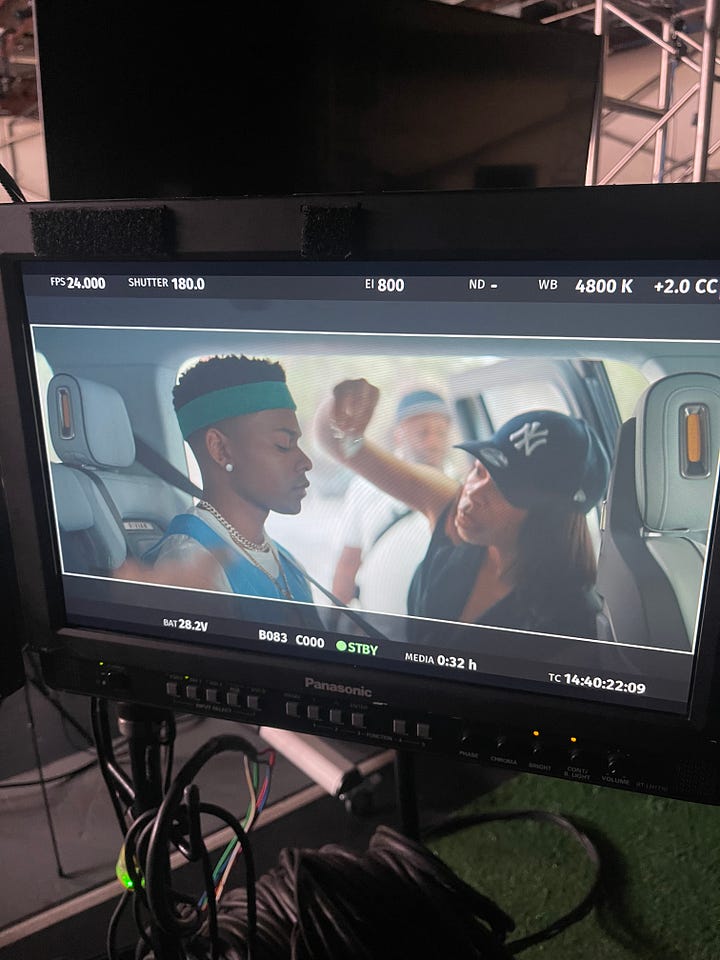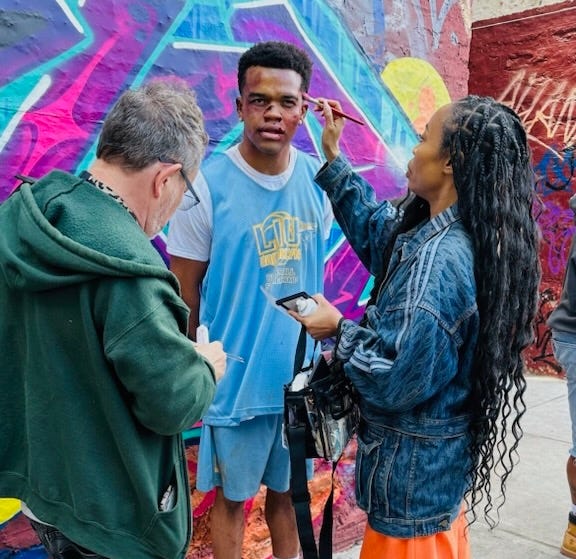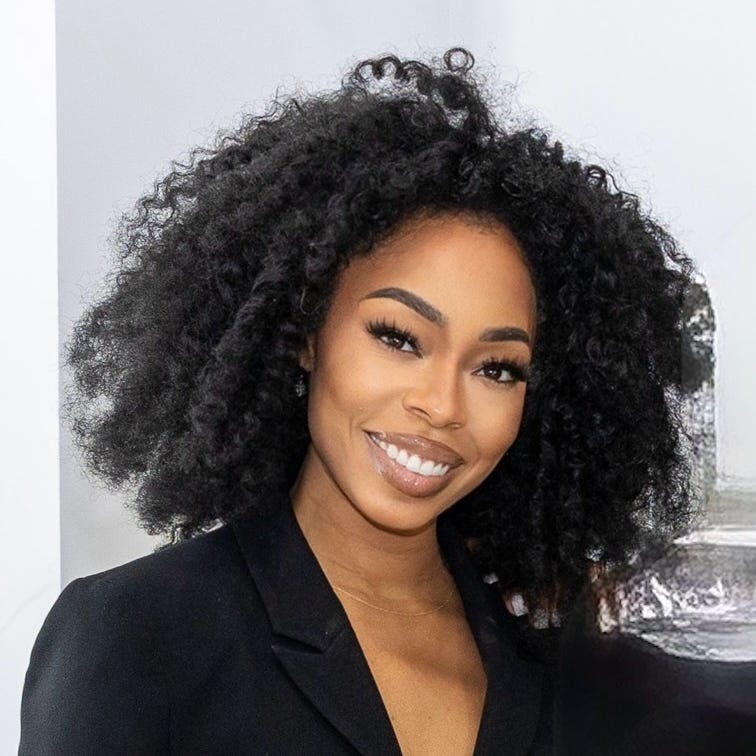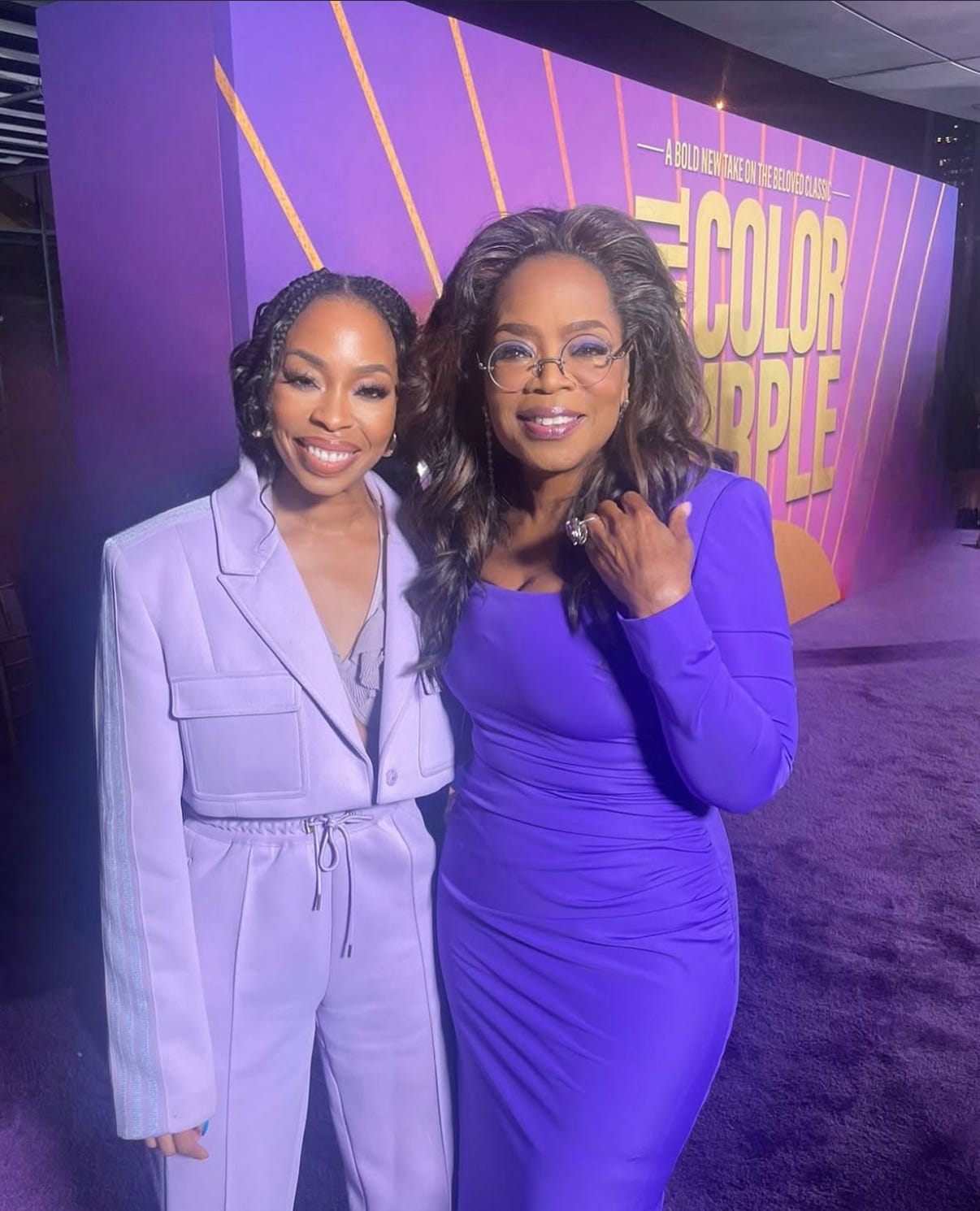CR 066: Ngozi Olandu Young on Makeup, Movies, and the Power of Chance Encounters
The makeup artist discusses her work on Spike Lee’s “Highest 2 Lowest,” and how a random meeting kick-started her impressive career.
Sometimes all it takes is a chance encounter to change the trajectory of one’s life.
When she was an 18-year-old college student, Baltimore native Ngozi Olandu was working part-time in Nordstrom’s makeup department, earning just enough money to cover car payments and meals. One day, she noticed a stranger hovering near the counter. “I had an older couple [at the counter],” she says. “They just purchased one lipstick, but they were with me for two hours. During that two-hour period, [this woman] kept circling around. I’m like, ‘I have a colleague who can help you.’ And she’s like, ‘No, I’m gonna wait for you.’ And I’m like, ‘Is she crazy? Why is she waiting?’”
After the couple left with their one item, the woman approached the counter and purchased $3,000 worth of makeup from Ngozi. “I was like, ‘Excuse me. I don’t mean to be tacky, but what do you do? [Laughs] Who are you?’ And she’s like, ‘I’m like you. I’m a makeup artist, but for film and television.’ It just blew my mind.”
The woman was Debi Young, a professional makeup artist and fellow Baltimore native who would go on to become Ngozi’s mentor and, years later, her mother-in-law. The meeting changed the course of Ngozi’s life, setting her on a path to becoming one of the most sought-after makeup artists working today. “I had no idea that makeup artistry existed in that capacity until I met Debi,” she says. “I thought people may do makeup for the news, but I never even thought about the film and TV routes at all until I met her.”
For more than 20 years, Ngozi has contributed her talents to a wide variety of critically acclaimed projects—among them, The Wire, We Own This City, Mare of Easttown, House of Cards, and The Color Purple—earning two NAACP Image Awards and two Emmy Award nominations along the way. Most recently, she served as makeup department head on Spike Lee’s Highest 2 Lowest.
From her home in Baltimore, Ngozi discussed her creative process, the importance of research, and the power of makeup as a narrative tool.
SANDRA EBEJER: Your first major credit on IMDb was The Wire. Having spoken to Debi Young and Janice Kinigopoulos, I know how bare bones that crew was. What did working on that series teach you? Is there anything you took from that experience that you’ve carried with you throughout your career?
NGOZI OLANDU YOUNG: Oh my goodness, so many things. Just watching how Janice, Debi, and our other colleagues, Sandy [Linn Koepper] and [Wyatt] Belton, interacted with not just the cast, but with producers and the communities that we filmed in. I mean, we were shooting in some rough places. You know, I’m learning and I’m observing, so if you’re panicking, I’m going to panic, because I’m in that learning mode. Never once were they like, “Oh, we’re in this awful neighborhood. Ick.” They would come out, they would speak to the people in the community, they would purchase Girl Scout cookies from kids. It showed me that this is deeper than just being in a Hollywood trailer. And then the relationship with the actors—they’re treating number one the same way they would treat number 1,001. It wasn’t like, “Dominic West is here, everyone! Let’s do this.” No, they treated everyone with the red carpet. It was like a true family.
One story that really stood out to me was during the Hamsterdam scenes. We were very tight on money with the budget. It was towards the end of the show, and Debi comes to me. She’s like, “Look, we have 180-something extras.” I was the only makeup artist back there, and I was like, “Okay. If she believes that I could do this, I’m going to have all these people done in a certain amount of time.” I was literally throwing bruises on people, having them have wounds and yellow teeth. And I remember one of the producers who’s a really tough cookie came to Debi and was like, “Wow. Everyone looks really good!” And I was like, “Oh. I can do this.” Because I was still questioning. Everyone’s been in this business for 10, 20-plus years by the time I got in, and it was something that I’d never seen or heard of. So it was very scary for me.
I would imagine that some actors, especially first-time performers, are nervous or self-conscious when they get into the makeup chair. How do you go about making everyone feel comfortable?
First, I try to center myself. You know, this is my intention, to make them feel as calm as possible. I start with myself first, whether that’s through my prayer, meditation, or both. And when we first meet, I want an actor to know it’s not about me and what I feel the character should look like. It is really a collaboration between myself, you [the actor], the producers, the director. It’s mixing all different sides of the filmmaking and TV making process. I really want people to feel at ease.
One thing I always tell them is, “If there’s anything I do that you do not like, let me know. It’s not about me and my vision. I want to know what you’re feeling and what you’re noticing, so you don’t have to think about your makeup while you are on set.” I just want to take one thing off their plate so they can focus on their work. And once I say that to actors, they’re like, “Oh my gosh. Thank you so much for that!” It’s an egotistical industry sometimes, so they’re used to people in their power [saying], “No! I think you should do this.” And they feel like a puppet, or they don’t have a say. So I try to empathize with a lot of the actors in that way and just be like, “I hear you. I know you’ve got to perform. I got your back.”
How was it to step into the role of makeup department head on Spike Lee’s Highest 2 Lowest, especially knowing that the film was going to have a lot of attention focused on it?
Unreal. Every New Year’s I’ll write my goals for the year, and then I’ll close it up and I won’t look at it. I remember that this was one of my goals: to department head a major movie with a major cast. That desire came up in me, just me writing, “What would be nice for 2025?” And it was so amazing. I felt like it was a dream.
I remember when I first told a lot of my colleagues, “I’m working—it’s Spike Lee, it’s Denzel Washington”—the number one thing they said was nothing about my talent. It was, “Be on your Ps and Qs, because [Spike] will pull up some things. He’ll be like, ‘We’re not going to shoot this. We’re going to shoot that.’ Be ready for changes. You have to be prepared on day one.” That was the only thing that was a little nerve-wracking. On day one, I had every single thing that I needed for the entire film. Usually you try to pace things out, but no, I had everything. So if he needed whatever, I had it. I was just crazy prepared.


In an Instagram post, you talked about makeup being “a narrative tool” and that it’s not just about the aesthetics. What is your process when you begin working on a project? How do you ensure that the makeup is going to support or enhance the story, and not distract from it?
Yes. For Highest 2 Lowest—A$AP Rocky and I didn’t verbally say this, but I knew from reading the script that he’s a struggling rap artist. For him to do something as desperate as to [take] a kid hostage—what would make someone go into desperation? Okay, he has a kid to feed. So although as handsome as he may look, I want his tattoos to look a little more faded. I mean, he looked nice, but things like his tattoos and under-eye bags and things like that.
There’s a part in the movie where he was having this dream. This is after he got arrested, where he was in jail and he’s playing a song for Denzel. And LaWanda [Pierre-Weston, hair department head] purposely had his braids a little fuzzy. I put a little bit of under-eye [makeup] under his eyes, so it’s like he’s dreaming. He’s doing his whole music video, but he’s really in jail. It’s like, this guy is not fully there in his mind. So we didn’t have him look as crisp and as nice as he usually would. But then you cut to right after that, he is talking to Mr. King, played by Denzel, and he has a crisp white durag, his nice Cartier glasses—he’s cleaned up. So just to show that contrast.
It’s a balance of, this is the character and this is part of the story that I want to tell with it not being too much or too distracting. Because there’s some films and movies that I’ve watched, and I’m like, “Oh, that’s way too much makeup.” It’s distracting or it takes you out of the film. So I want to be as realistic as possible, so you literally feel like you’re there watching Denzel and A$AP Rocky go back and forth like a ping-pong match or something. That’s always my goal.
Do you typically get a script in advance and go through each scene before the filming begins?
A lot of shows, you’ll get the script even before you take the job. I’ll say, “Let me see the script before I accept, just to see what everything entails and what the budget looks like, and what the vision is that the director might want or producers might want.” But then there are times that you can say yes to the job and you have no script, which was the case with Highest 2 Lowest. That was crazy. I’m like, “Okay, yeah. I’ll do the job. But...what is it about?” Everyone’s like, “It’s Spike Lee! What are you questioning?” So I signed up for that without having a script in hand, which is very different than how it has gone for me for the past 20-plus years. Usually, I’ll get the script first, go with an interview, and then go from there. But that was the first time I ever said yes without having the script. I mean, you know, it’s Spike Lee.
So then how do you know what to do? I assume you got the script at some point after you agreed to it.
Yes. After you get the script, it can [go] so many different ways. There have been shows where I’ve had intense meetings with directors. The director’s saying, “I would love for the skin to look like this. What are your thoughts?” But then there are a lot of other films where the director says nothing. They’re trusting you to do your work, and that’s more of the collaborative effort of me as the makeup artist with the actor. I’m trying to think of every scenario, because there have been a lot of times where the director has been like, “That is wonderful. I didn’t even think you could do that!” And I’m working with the hair person, and we’re working it out, me reading off the pages, [asking] how can we make this look as realistic as possible with what we have in front of us? It could be anything like filling in their eyebrows deeper or darker, so they can look more menacing, or adding a fake pimple if they’re a wreck or if they’re having hormonal things happening as a teenager. It could be adding some redness to the nose. Just these little, small, realistic things that you get from reading a script. It’s deeper than just what’s on the page. I want to convey a feeling to the audience.
When working on something like Mare of Easttown, which is set in Pennsylvania, or The Color Purple, which covers a specific time period, do you do a lot of research before filming begins?
Absolutely, especially with period pieces like The Color Purple. We had a 40-year span. We went from the early 1900s to the 1950s. We were looking at nail shapes, the different lipsticks that were around in those times, where they lived in the state, and what was actually available for them to buy during that time. You can always Google “1940s makeup.” I wanted to go deeper. We went to the library and got actual books that came out around that time. We did a lot of research. Again, authenticity was the goal.
Some of your projects—Highest 2 Lowest, The Wire, Mare of Easttown, to name a few—have more grit than glamour. And it seems like the grit might be more difficult to pull off because you don’t want people to notice the makeup. Do you prefer one type of project over another?
I love them all. When I first started in this business, beauty was where I began. I love beauty and the confidence that people have with beauty, but there’s a whole other confidence when you take someone as beautiful as like, you know, a Halle Bailey or somebody, and you break them down and they have the confidence to be like, “I can play this not-so-pretty role and step into it fully.” So I love both. I love the grit and the beauty. I have no preference. I love them both equally.
At this stage of your career, what type of projects appeal to you most? Is there something that a film or TV series has to have in order for you to commit to it?
I would say the projects have to have something for the audience to walk away with. There’s something that speaks to me as a human. I’m always about the message and the intention of the film. That is always a deal breaker for me. If I feel like something isn’t sitting right with me, thank God I’m at the point where I can bow out of a job and just pass it on to someone else who could possibly do it. At first, I would just say yes to everything, because [there] was an article I read probably 20 years ago. I think it was Samuel L. Jackson. He just said yes to every single project. And I was like, “Okay, if I say yes to everything, that’ll get the momentum going with my work.” Then after a while, I’m like, “No. I’m not going to be saying yes to everything.” [Laughs] Actually, there was a horror film that Debi and I got called to do, and we did one day, and we were like, “No. This is not for me. Not doing it.” The energy was not good at all.
Who are your influences? Are there any artists you turn to when you’re seeking inspiration?
On a makeup artist level, there’s people like Pat McGrath, Sam Fine, and Debi, who were great influences of placement and how I like the skin to look. But I also love going to museums and finding new artists. There’s a beautiful museum here called the American Visionary Art Museum, where my husband actually proposed to me, and I love going there. I get so filled up by artists I never even knew of—up-and-coming artists, artists that may have been quote-unquote forgotten about but still are living through their artwork. And architecture—[there are] different architects that I love, too. I just pull from everywhere.
That’s great. What do you love most about your job?
I love the transformation process. I love for someone to walk through the trailer as their regular selves and leave my chair and go on set as a whole other person. I love to be a vessel to witness that and to also help create and support that. That’s what gets me going. I love it. It is just a little piece of the puzzle to make them in a whole other character. It takes them to another dimension, and I’m able to help and support them to do that. That fills me up.
It’s a challenging time right now to be a creative. Film and TV production has slowed down, and stable work is hard to come by. With that in mind, what is your advice to those who want to follow in your footsteps?
[Sighs] Oh, this is a great question, and I’ll just be real. I hope this doesn’t sound bad, but I’ve been telling a lot of my mentees who want to do this, “This is great. This is amazing. You can put all your eggs in one basket, but make sure you have your cushion set up, whether that’s your financial savings or making sure you have people around to support you.” I mean, I have people who look into this as a second career, and they’re like, “Should I not do this?” You can still pursue it, but things are changing. I’m telling my mentees, “I know you’re against the whole AI thing, but take the AI courses, just so you’re familiar with it. I’m not saying I’m advocating for that stuff to happen, but just so you know and understand what is going on, because things could be shifting.” I just want people who haven’t been in this—or people who are already in this—industry to be prepared. I’m also telling a lot of my mentees to call on your network. You have a friend who is a DP? Great. You all can make a film. Such-and-such is a writer? Collaborate. Right now is the time for collaboration and preparation. That’s what I feel when it’s slow.
It’s a hard time right now for a lot of people. And it’s okay to pivot into another job, just to get you through this rough patch. A lot of my makeup friends are going into salons and doing hair. Some makeup artists also do nails. They’re just adding on to what they do. I know people may feel like you’re shifting your focus, but we have to survive as artists, as well.
To learn more about Ngozi Olandu Young, find her on Instagram.
This interview has been edited for clarity and length.
You might also enjoy…







beautiful piece sandy! 💜